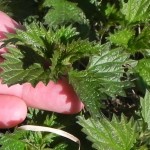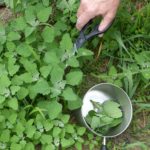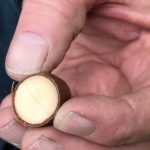by Winding Pathways | Apr 28, 2022 | (Sub)Urban Homesteading, Chickens, Foraging, Garden/Yard, Garden/Yard, Weeds
We are shocked by the rise of many prices, especially food. Fortunately, we mute the cost by finding or growing groceries here at Winding Pathways. We’re lucky to own two acres, but folks living on tiny lots can produce an amazing amount of food, even if they aren’t passionate gardeners.
In a nutshell here’s what we do to tame grocery bills:
Foraging
It’s ironic that many people consider the most delicious and easy wild foods pests and spend time and money trying to eliminate them. We eat ‘em. Books and websites, including Winding Pathways, share tips on finding, identifying, harvesting, cooking, and eating wild foods. Caveat: ALWAYS check that you have the correct plant, gather from unpolluted places, and consume only a small amount initially to be sure your body accepts the wild edible.
Here are our favorites:
Gardening
We’re not passionate gardeners and we don’t can or freeze vegetables, so here’s what we do:
- Succession plant: Our small garden yields an enormous amount of food. We don’t let a square foot be idle. When summer’s heat turns lettuce bitter, we pull it, feed it to our chickens, and plant beans or another heat-loving crop. Same with other crops that grow quickly and then fade.
- Use vertical space: Pole beans, for example, produce much more food per square foot than bush beans, so we choose climbers and use vertical space. We have the pole high enough to reach up and pull off the beans.
- Grow dwarfs: Some cucumber varieties, for example, are “bush” type, meaning they produce a crop without long vines that consume plenty of space.
- Think of winter eating: Because we lack freezer space and don’t can food, we plant vegetables that need little care during the growing season and store them until late winter without being canned or frozen. Here’s our list:
-
- Winter squash. Pick them, let them curet, and store them in a cool spot. They keep for months. Same with pie pumpkins.
- Carrots and parsnips. In late fall we smother the plants with a thick blanket of dry leaves or straw that keeps the ground from freezing. We’ve harvested carrots in January by brushing away snow and peeling back the mulch and pulling them.
- Sweet potatoes. They love the South’s climate yet grow well up north.
We carefully dig them in the fall, cure them, and store them like winter squash.
-

-
Sweet potatoes are a healthy vegetable.
-
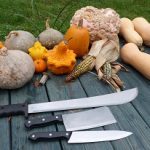
-
Winter Squash vary in color, texture, shape and size.
Chickens
We can’t imagine living without a small chicken flock. Our six to 12 hens gift us a couple of dozen eggs a week. Their manure fertilizes the garden and garden weeds are a great hen chow. During warm months our hens forage in their large run eating bugs, worms, and weeds and transforming them into eggs. Sometimes we even stew down an old hen.
-
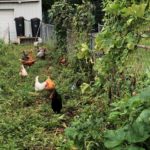
-
In the summer hens find plenty to eat.
-
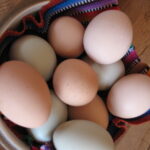
-
The chickens kept on laying eggs.
-
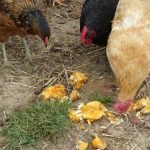
-
Chickens efficiently recycle squash seeds to eggs.
Wildlife
Lots of folks don’t like hunting. For us harvesting a deer is a form of food gathering, not recreation. After all, deer are free-ranging, local, and organic. Fortunately, we’re able to hunt on our property and convert a deer into delicious meat. We also enjoy eating panfish.
Like most folks, we can’t grow or forage all our food but much comes from the yard and area. It takes knowledge and investment in elbow grease but trims the food budget. Perhaps even better, knowing how to find and grow food makes us feel less vulnerable to national disruptions that make food either hard to get or expensive.
by Winding Pathways | Mar 17, 2022 | (Sub)Urban Homesteading, Garden/Yard, Garden/Yard
As we watched squirrels gleaning sunflower seeds from feeders in our backyard, we dined on 2021s sunshine!
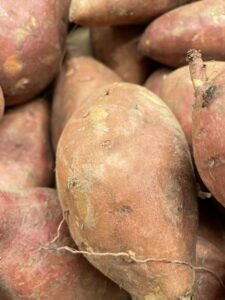
Sweet potatoes are a healthy vegetable.
Thanks to last season’s sun our crop of sweet potatoes produced a bountiful crop, and we ate them until our last one became part of our February 8th dinner. We’ve only been growing sweet potatoes for a few years because we’d heard they need a long southern summer to mature. We now know that’s not true.
We love sweet potatoes. They come in many varieties and color shades from white to purple and the common ones with deep orange flesh. This nutritious plant originated from tropical South America and is now grown in warm regions all over the world. Sometimes they are called yams, but these two plants are distinctly different. Yams originated in Africa.
Nutritious Vegetable
We love the taste and nutrition of sweet potatoes but here are some other ways we love this plant:
- They are easy to grow. We buy “slips” and plant them in late May or early June.
- The plants and flowers are gorgeous, and slips are sometimes sold as ornamentals.
- They store well. We carefully dig them before the first frost, let them cure for a couple of weeks, and then store them in a cool dark place. They last all winter.
Sweet potatoes are easy. No freezing or canning is needed. We plant, weed a bit, dig, cure, and store and then enjoy eating them all winter. This year we’ve ordered a variety of sweet potato slips from Sand Hill Preservation Center and look forward to a larger harvest. The company also sells heritage chicken breeds and vegetable seeds.
by Winding Pathways | Feb 3, 2022 | Birds, Garden/Yard, Nature, Uncategorized
Millions of families love watching chickadees, nuthatches and woodpeckers visit backyard feeders. A joyful daily task is bringing them a day’s supply of sunflower seeds, millet, or even cracked corn. But, often an important part of their diet is ignored.
Birds lack teeth so never need dental care. Instead, they must eat rocks! Small rocks humans call sand. Often birds forage along snowy roads gleaning grit spread to give cars traction. It goes into their gizzard where powerful muscles grind seeds into a digestible slurry that then moves on to the stomach.
During most of the year, birds find all the grit they need on their own, but when snow and ice seal off the soil they can’t find it. People sometimes scatter sand on slippery spots to provide human traction. Birds will glean some of it.
It’s helpful to sprinkle a handful of sand around feeders once a week during the snowy season. At Winding Pathways, we buy a 50-pound bag of chick grit at a local store that sells chicken feed. It’s fine ground hard rock that is ideal for both traction and bird digestion but plain old sand works.
Wild Turkeys often visit our feeders, so once in a while, we toss out large-sized grit, designed for laying hens. It helps their gizzards grind up hard corn kernels that they love snacking on.
An outstanding source of bird information is the Cornell University Laboratory of Ornithology.
-
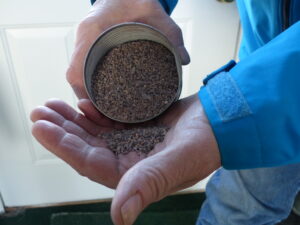
-
Chick grit is small.
-
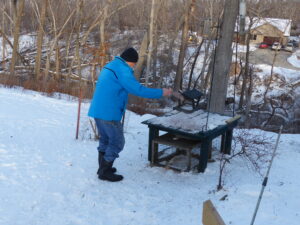
-
Sprinkle grit once a week to help birds in the snowy season.
-
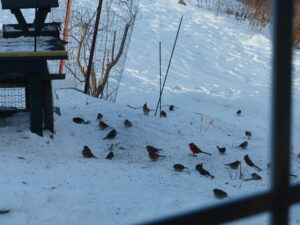
-
Birds flock to the seeds.
by Winding Pathways | Jan 20, 2022 | (Sub)Urban Homesteading, Energy Efficiency, Garden/Yard
Back in October, we took a gamble. We bought an electric snowblower. Our driveway at Winding Pathways is about 440 feet long, and Iowa gets plenty of snow. It’s too much to shovel, so years ago we bought a gas snow blower. It worked for the first winter but then it started throwing belts off the drive wheels. Fixing was tedious and tenuous. So, we sold the beast and bought an EGO battery-powered two-stage snowblower.
We hoped it was a good decision. Would the blower be up to clearing such a long driveway? Would it hold up to hard use?
A heavy wet snowfall on December 28, 2021, gave us a chance to test the new machine. It did just fine. After clearing the entire driveway, the batteries still had charge to them. We could have done more.
It’s our prediction that gasoline-powered lawnmowers, hedge trimmers, blowers, chainsaws, and snow blowers are becoming obsolete. They’ve already been banned in California because they pollute the air more than cars.
Here are aspects of battery tools we like:
- They run quietly and are lightweight.
- No need to risk shoulder injury by pulling a rope to start it up. Just push a switch.
- No need to store gasoline.
- Maintenance is easy. No filters or spark plug to change.
- No fumes.
- Inexpensive to run. It costs less to recharge the battery than to buy an energy equivalent amount of gas.
It looks like our decision will pay off. We’ve now replaced all our gas-burning outdoor equipment with battery equivalents……except for one chainsaw. That may go soon.
Note: Winding Pathways paid the full retail price for this machine.
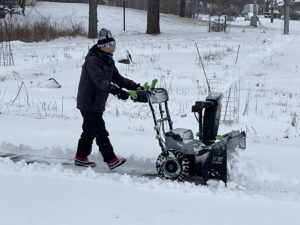
The EGO snowblower cut through the heavy snow easily.
by Winding Pathways | Jan 5, 2022 | (Sub)Urban Homesteading, Flowers/Grasses, Garden/Yard, Garden/Yard, Nature
A raging blizzard roaring over Winding Pathways just before Christmas 2022 showed us the power of HARVESTING SNOW. We love catching it. Other parts of the country endure blizzards, especially Nor’ Easters
Well, we didn’t really catch the snow, but our prairie did. It has a talent for harvesting snow and other forms of moisture. It taught us how prairie and other taller plants – grasses, forbs, shrubs, vines, and trees – help themselves grow next summer.
Our prairie has a thick growth of two-foot-tall dead stems from last summer’s growth. Each stalk is brittle, but thousands of them working together slowed the wind just enough for it to drop the snow it had swept off nearby lawns and roads.
The deep drift that settled on our prairie will melt and give next spring’s plants a jumpstart in moist soil. Nearby shortly sheared lawns can’t catch snow and will start the spring on dryer soil. Nature delivered irrigation water to our yard for free!
Sharing Nature’s Wisdom
In dry regions of the country, snow also helps next summer’s vegetables. During college, Rich worked weekends at an Idaho ranch. He was surprised one January when Lucille Pratt, part owner of the land and an outstanding vegetable gardener, asked him to shovel a snow drift from nearby onto the garden.
For a Jersey boy, this seemed like a weird request. He did as asked and learned that melting snow oozed water into the soil. That helped get the vegetables going come spring and sustained them through the dry north Idaho summers.
Snow may be a bother to some, but it’s also a blessing to dry soil and the plants it sustains.
Over two blizzardy days, our prairie gently caught snowflake after snowflake. We already are looking forward to bright prairie flowers dancing in next summer’s breeze. Thanks, prairie for harvesting snow. Nature’s wisdom to catch winter’s snow and help next summer’s growth is amazing.
-
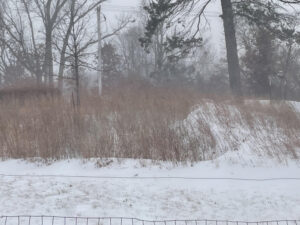
-
Capturing snow.
-
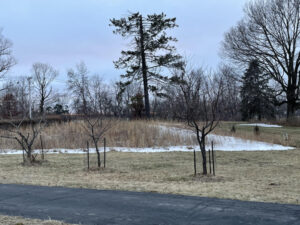
-
Three days later, a rapid melt left the ground bare, except where prairie plants held snow.
by Winding Pathways | Nov 11, 2021 | (Sub)Urban Homesteading, Birds, Garden/Yard, Nature
“A woodpecker is hammering on my house. It’s damaging my siding and driving me nuts. What can I do?” asked a longtime friend.
Woodpeckers often hammer on buildings, and we’ve taken dozens of calls from homeowners seeking relief. There are ways to discourage the plucky birds.
Woodpeckers bang on wood for at least three reasons:
- Drumming. Drumming on wood or metal in a rapid burst announces the bird’s presence to others. It is loud advertising.
- Nesting. Woodpeckers excavate cavities, usually in dead trees, to make a safe comfortable nest in the spring. A snug nest within an insulated wall is a great substitute for a tree.
- Food. Woodpeckers make their living dining on insects lurking in wood. Commonly this is a fall and winter activity, especially on home sided with rustic
T 111 plywood.
We love woodpeckers, and so do most people. But, no one wants damage to their home. So, how can it be prevented?
Prevention
It’s tough to stop drumming, but the good news is that it is usually of short duration in the spring and rarely damages the home.
It is difficult to stop birds from excavating a nest, but fortunately this is relatively rare. The long-term solution is to side the home with a durable hard material. Bricks are ideal.
Foraging may be the most common home damage. It can be extensive and comes with annoying noise as the bird removes wood to expose hidden bugs. Here are some solutions:
If building a new home, specify siding that lacks holes and cracks. If no insects can enter woodpeckers have no reason to try to extract them.
- With a caulking gun and putty knife plug every possible hole in the home’s exterior in late winter or early spring. This prevents insects from entering.
- If a woodpecker is foraging on a small section of the house draping light duty netting, the material sold to keep birds off cherry trees, will physically keep the birds away. Sometimes it can be stapled to an overhanging eve and to the siding below.
- Luring a bird away from the home may work. Erect a suet feeder 40 or 50 feet away from the house. The woodpecker might prefer eating easy-to-get suet instead of digging bugs out of the home.
-
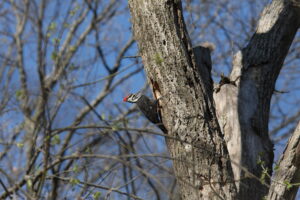
-
The Pileated woodpecker – Woody Woodpecker – is a sight to see!
-
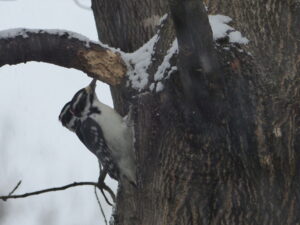
-
Woodpeckers dig for insects on trees.
-
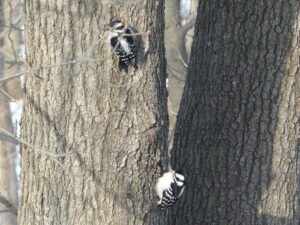
-
These woodpeckers are happy to forage for insects on a tree trunk.
Perhaps the best strategy for enjoying woodpeckers but preventing damage is to protect nearby dead trees. If a tree poses no falling threat to a structure, car, or person, leaving it in place gives woodpeckers a place to drum, nest, and find tasty insect meals.
Woodpeckers are amazing and beautiful animals that bring us joy. We are fortunate to have hairy, downy, red-bellied, red-headed, pileated, flicker, and sapsucker at Winding Pathways. They enjoy our feeders and leave the house alone.
-
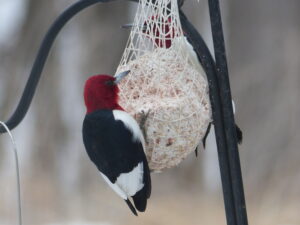
-
Woodpeckers would rather eat from a suet ball than drill on a house.
-
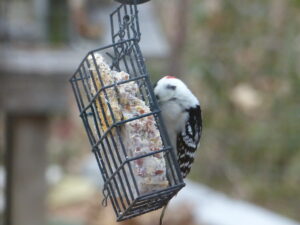
-
We’ve had all sorts of interesting woodpeckers at the feeders.
-
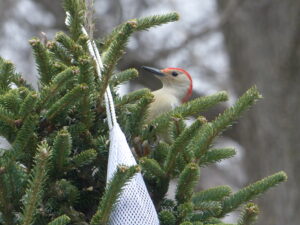
-
We tuck suet in Evergreen trees for the birds to enjoy.

